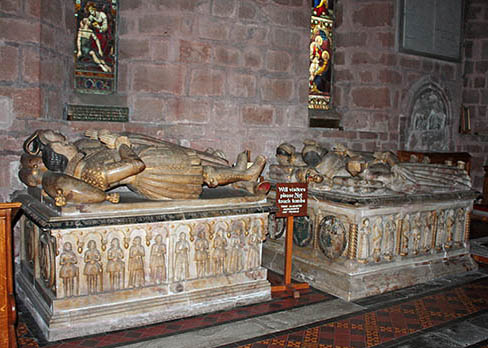 |
 |
|
| St. Mary and St. Chad, Brewood | View of the nave and chancel | |
 |
 |
|
| Gifford tombs, north side, 2010 | Gifford tombs, south side, 2010 |
 |
 |
|
| St. Mary and St. Chad, Brewood | View of the nave and chancel | |
 |
 |
|
| Gifford tombs, north side, 2010 | Gifford tombs, south side, 2010 |
 |
   |
 |
| Gifford tombs, north side | The font | Gifford tombs, south side |
I was fortunate to visit St. Mary and St. Chad on a Sunday afternoon when the church was open to visitors and volunteer stewards were available to explain the many interesting features in the church.
The bishops of Lichfield owned a manor at Brewood and were patrons of the church. The chancel dates from the 13th century. The east wall was modified in the 18th century and again in 1879. The nave arcades, with five bays are 14th century but were probably increased in height in the 16th century. The pillars are octagonal. The north aisle has windows in the Decorated style. The south aisle was restored by the architect Street in 1878-1880 when he created a new outer aisle. The tower dates from about 1500 and the current entrance is through the west side of the tower. There was formerly the usual south door and porch but these were removed in the 1770s.
Of particular interest are the four huge tombs of the Gifford family, two on each side of the chancel with in each case one bearing two effigies and one bearing three as shown in the two photographs. The Giffords lived at Chillington Hall. The oldest is on the south side of the chancel and dates from 1556. It depicts Sir John Gifford and his two wives. Sir John is shown with black hair and beard in armour such as he would have worn at the Field of the Cloth of Gold, when Henry VIII gave him Black Ladies convent. The panels on the sides show 13 children who died at birth or in infancy together with one son and four daughters. He died at the age of 90, four years before his son Thomas. Behind in the picture is the tomb of Sir Walter Gifford (died 1632) and his wife.
On the north side, is the tomb of Sir Thomas Gifford, son of Sir John, who died in 1560, with his two wives, who between them had 17 children. Behind is the tomb of John Gifford, who died in 1613, and his wife, Phillipa. He died after long imprisonment for being a Catholic. Fourteen children are shown on the tomb, one of whom was Sir Walter mentioned above. I returned in January 2010 and attempted new pictures from the side.
The Giffords of Chillington are one of those rare families that trace their ancestry to before the Norman Conquest. They were counts of Longueville. Peter Giffard fought in Ireland in the 12th century and was rewarded with lands in Staffordshire, including Chillington, in about 1180. There then began an unbroken line of male heirs for 800 years. Sir John Gifford, whose tomb is mentioned above, was the first of the line to play a part in national affairs. He was a soldier, a member of Parliament and Henry VIII's standard bearer. He is celebrated in a local story as a huntsman. He had received a leopard as a gift and which escaped into the grounds of the house. Sir John and his son gave chase with cross-bows and as the leopard approached a woman with a baby Sir John shot the leopard. An old cross is said to mark the place of this feat of archery. As a result, Sir John was given the right to use a leopard's head, bearded archer and cross-bow on his armorial bearings. The motto, "Take Breath, pull strong" is said to have been said by his son as he prepared to shoot.
The Gifford family, although they gained land from the Dissolution, nevertheless remained attached to the old religion for some time. Gilbert Gifford, son of John Gifford, mentioned above, was notorious for his double-dealing. He was born in 1561 and educated abroad by Jesuits at a time when this was illegal in England. Subsequently he sold information to Elizabeth I's supporters and then gave information on them back to the Jesuits. He became involved in the Babbington plot against Elizabeth, organised by supporters of Mary Queen of Scots. It was his idea to secrete messages in the false bottoms of beer barrels entering Queen Mary's quarters at Chartley. Later he went to France and died in 1590. Thereafter the Giffords were loyal to the monarch and Peter Gifford, at the age of 61, became the Royalist garrison commander of Nottingham. It was through the Gifford's ownership of Boscobel and their servants, the Pendrells, that Charles II was able to escape after the Battle of Worcester in 1651.
Chillington Hall, the home of the Giffords, is the third house on that site. The Tudor manor was replaced in two phases. The south side was rebuilt in 1724 and the north in 1786 when the remainder of the Tudor house was demolished. The park was landscaped by Capability Brown. The house is not open to the public on a regular basis but I visited with a party from the Friends of Tabley House. The front of the house was covered in scaffolding at the time and so no pictures are shown here.
The Buildings of England, Staffordshire, by Nikolaus Pevsner, Penguin,
1974, ISBN 0 14 071046 9
The Old Parish Churches of Staffordshire, by Mike Salter, Folly Publications,
1996.
The King's England, Staffordshire, by Arthur Mee, Hodder and Stoughton,
London, first published in 1937.